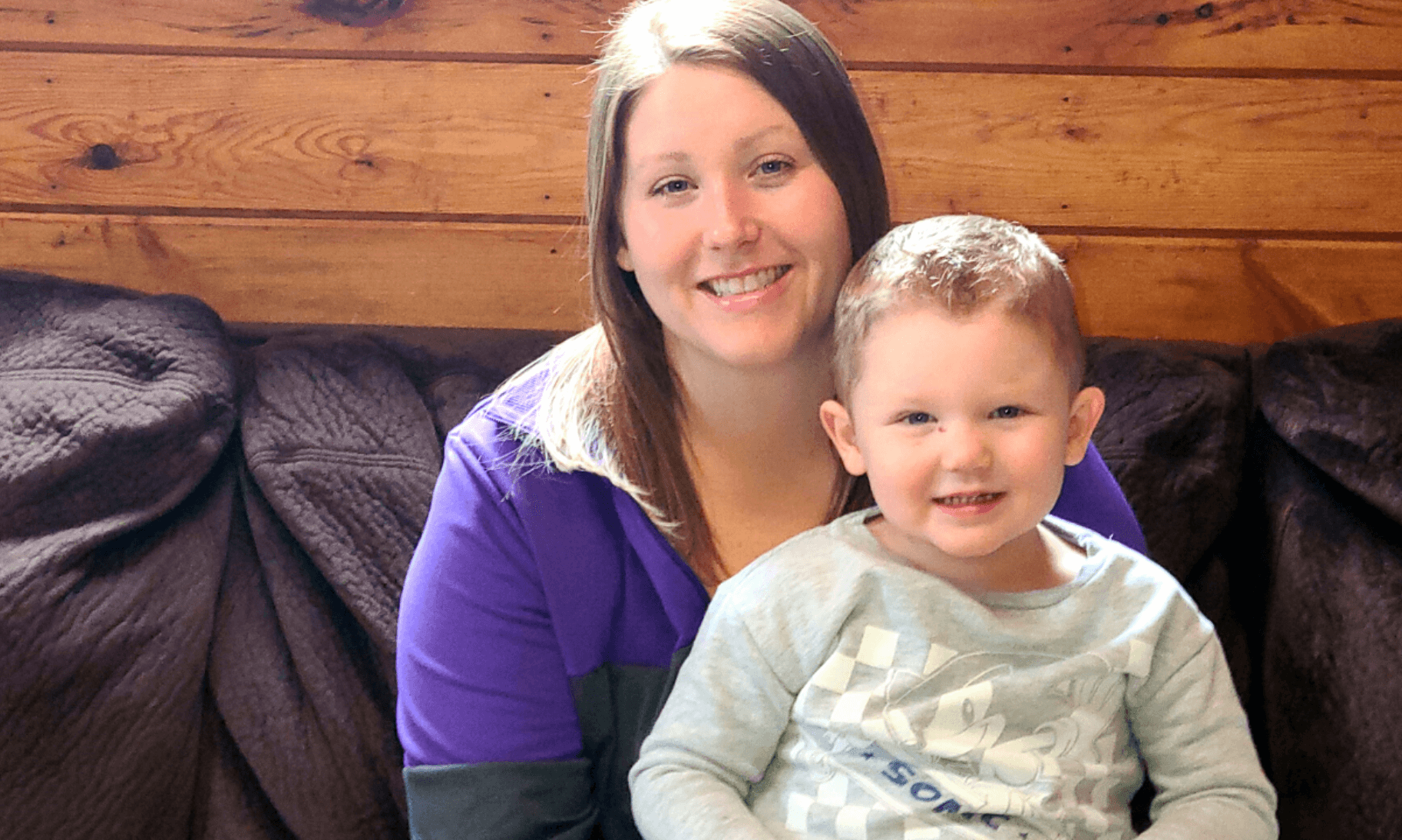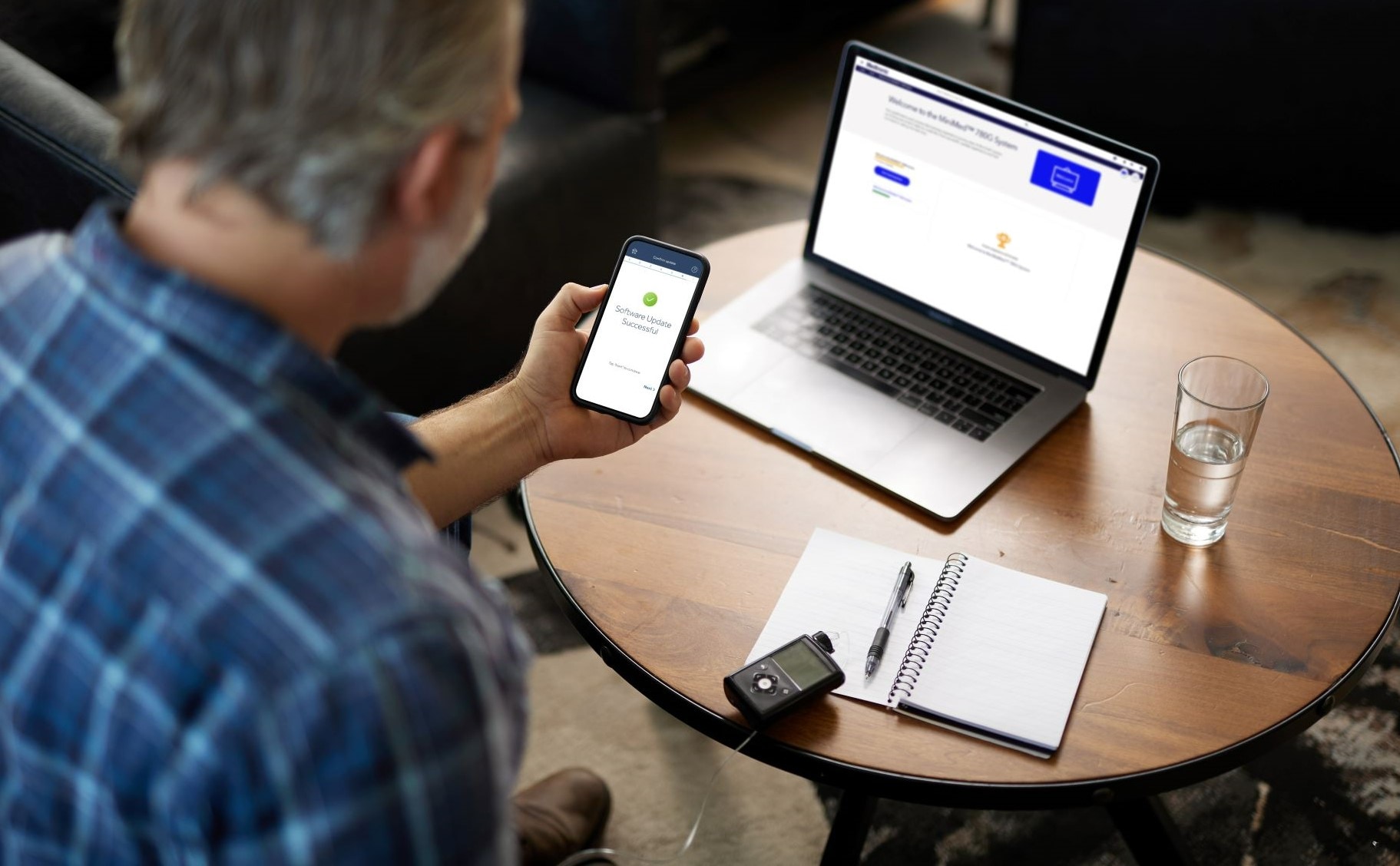Having a child on the MiniMed 770G system — Q&A with Natasha

When three-year-old Mason isn’t running around as fast as Sonic the Hedgehog, his family is helping to manage his type 1 diabetes. When Mason was diagnosed at 16 months old, his mom Natasha, jumped in and learned everything possible about how to help him feel good and live a full life. I sat down with her to learn more about how his diagnosis changed their family and their experience with the new MiniMedTM 770G system. I think you’ll agree that this family is incredibly sweet and resilient!
1. What do you wish you knew when Mason was first diagnosed?
When Mason was diagnosed, they gave us so much information. You forget everything they tell you. One of the things we struggled with in the beginning (and still do) is how your body processes carbs. With trial and error, we’ve had to come up with our own plan for foods like pasta. Advice I could give other parents with young kids with type 1 diabetes is to research each food and how it processes in the body. And then see what works best, since each kid is different.
2. What are your best tips for other parents of children with diabetes?
I would suggest having a very good support system (friends, family, care team). Everyone's always told me it takes a village to raise one child. With a child with type 1 diabetes, it takes a huge village; you need all the help and support you can get. Also getting involved with support groups of parents that have children with diabetes would be a really good idea. Everyone has good suggestions of how to make life a little easier, and it helps just knowing that you are not alone.
3. What is the biggest difference you experienced switching from multiple daily injections to insulin pump therapy and continuous glucose monitoring?
For us, multiple injections were very difficult. Mason was only 16 months old when he got diagnosed and it is very hard to poke your child that many times a day. It was a huge relief to get on a pump after he turned two. With the MiniMedTM 770G system, we are very happy to have the Bluetooth capability to be able to see Mason's sugar levels on our phone. One of the other things that makes life a little bit easier is having Temp Target with activities. It helps maintain his sugar to more of a normal level with less dropping. The MiniMedTM 770G system gives both of us more freedom to live a happy healthy life.
4. What would you share with other parents figuring out the best way to manage a pump and sensor?
He has always worn his pump in a kids SPIbelt waist pouch. It was the best way to keep his pump safe and away from him, so he's not pushing buttons. He also sleeps with it on. Now that he has a smartphone, we’re switching to a larger fanny pack to hold that along with his pump. I would suggest talking to your care team if you think that where you’re putting it is not working out the best for you. As far as being comfortable with inserting them, the best thing for us was looking at the online videos on the Medtronic website.
5. Tell me about training, do you have any tips for parents going through this process?
Our first training session was overwhelming since Mason's received his first pump 8 months after his diagnosis. We were lucky to have Kathy from Medtronic who did our training session. She was very kind and patient and made me feel so much less overwhelmed. I knew that if I needed something at home when I wasn't comfortable that I could message her or our care team for questions, which is a huge relief. We found the Medtronic training videos very helpful the first time we inserted by ourselves at home. We watched a few videos to refresh our memory.
7. What’s set you up for success with the sensor?
We calibrate his sensor every morning when he wakes up, before lunch, and before bed. We also make sure that we are dosing him the proper times before meals depending on what his blood sugar levels are. It makes a big difference with sensor readings and maintaining normal levels. 
8. Which device do you use for the MiniMedTM Mobile app (his data to be transmitted from the pump) and which do you use for the care partner app, CareLinkTM Connect?
When we first got the app, my phone was Mason's primary smartphone device, so I stayed nearby and used the MiniMed Mobile app to monitor him. Then on my husband's phone, we used the care partner app. Since Mason will be going to pre-school soon, we just got him his own smartphone (with no games on it!) The care partner app is used by three of us: me, my husband, and my mother-in-law (since she helps babysit.) This is really nice when I am not with him to be able to see what his sugar levels are at and feeling reassured that he’s doing ok.
9. How has the MiniMedTM 770G system changed your daily life?
The MiniMedTM 770G system has changed our lives in so many different ways, and we are so thankful for the technology. Since the day Mason was diagnosed, he was sleeping in bed with me for safety reasons. I didn't feel comfortable having him too far away. Now that we have the new system, he has been in his bunk bed on his own and he is loving it. Daytime has changed a lot. Since we have the new Bluetooth technology, now I don't have to hover over him anymore. I don’t chase him around the house to check his pump to see where his levels are at. (He does know to alert us when his pump goes off for highs and lows. We typically know what's going on since we have the Bluetooth capability before he alerts us.) Now I'm able to just look at my phone which is giving him more independence and freedom to be a normal happy healthy three-year-old.
11. Tell me about the automatic uploads to CareLinkTM Personal via the app.
I am so thankful that the new app automatically uploads his data to the CareLinkTM software. I look at CareLinkTM reports once a week to once a month, depending on how he’s doing. Uploads are one less thing I have to worry about doing. The other nice thing about it is that his care team always has his sugar levels whenever they need them if we need to adjust his insulin settings in his pump.
12. Are there any tips you have for parents of young children to improve their experience with the MiniMedTM 770G system?
- From our experience, trust the system to do its job. Let SmartGuardTM Auto Mode correct for highs on its own (unless the pump recommends giving an extra bolus).
- Make sure that your app notification settings are the way you want them to be within CareLink, your app settings, and your personal smartphone settings. I felt like I was getting too many alerts, so I made some changes and now it’s much better.
-
To continue to learn, the best resource for us was the Medtronic website. Watching all the videos was really informational with the new pump.
Hope you enjoyed this exclusive interview! 😉 What questions do you have about the MiniMedTM 770G system? The testimonial is of an individual’s experience using a Medtronic device. Talk to your doctor about your health and the risks and benefits of Medtronic devices.
Important Safety Information MINIMED™ 770G SYSTEM WITH SMARTGUARD™ TECHNOLOGY
The MiniMed™ 770G system is intended for continuous delivery of basal insulin (at user selectable rates) and administration of insulin boluses (in user selectable amounts) for the management of type 1 diabetes mellitus in persons two years of age and older requiring insulin as well as for the continuous monitoring and trending of glucose levels in the fluid under the skin. The MiniMed™ 770G system includes SmartGuard™ technology, which can be programmed to automatically adjust delivery of basal insulin based on continuous glucose monitoring (CGM) sensor glucose (SG) values and can suspend delivery of insulin when the SG value falls below or is predicted to fall below predefined threshold values.
The Medtronic MiniMed™ 770G system consists of the following devices: MiniMed™ 770G insulin pump, the Guardian™ Link (3) transmitter, the Guardian™ Sensor (3), one-press serter, the Accu-Chek® Guide Link blood glucose meter, and the Accu-Chek® Guide test strips. The system requires a prescription.
The Guardian™ Sensor (3) has not been evaluated and is not intended to be used directly for making therapy adjustments, but rather to provide an indication of when a fingerstick may be required. All therapy adjustments should be based on measurements obtained using a blood glucose meter and not on values provided by the Guardian™ Sensor (3).
All therapy adjustments should be based on measurements obtained using the Accu-Chek® Guide Link blood glucose meter and not on values provided by the Guardian™ Sensor (3). Always check the pump display to ensure the glucose result shown agrees with the glucose results shown on the Accu-Chek® Guide Link blood glucose meter. Do not calibrate your CGM device or calculate a bolus using a blood glucose meter result taken from an Alternative Site. It is not recommended to calibrate your CGM device when sensor or blood glucose values are changing rapidly, e.g., following a meal or physical exercise.
WARNING: Do not use the SmartGuard™ Auto Mode for people who require less than 8 units or more than 250 units of total daily insulin per day. A total daily dose of at least 8 units, but no more than 250 units, is required to operate in SmartGuard™ Auto Mode. |
WARNING: Do not use the MiniMed™ 770G system until appropriate training has been received from a healthcare professional. Training is essential to ensure the safe use of the MiniMed™ 770G system.
Pump therapy is not recommended for people whose vision or hearing does not allow recognition of pump signals and alarms. Pump therapy is not recommended for people who are unwilling or unable to maintain contact with their healthcare professional. The safety of the MiniMed™ 770G system has not been studied in pregnant women. For complete details of the system, including product and important safety information such as indications, contraindications, warnings and precautions associated with system and its components, please consult http://www.medtronicdiabetes.com/important-safety-information#minimed-770g and the appropriate user guide at http://www.medtronicdiabetes.com/download-library.



